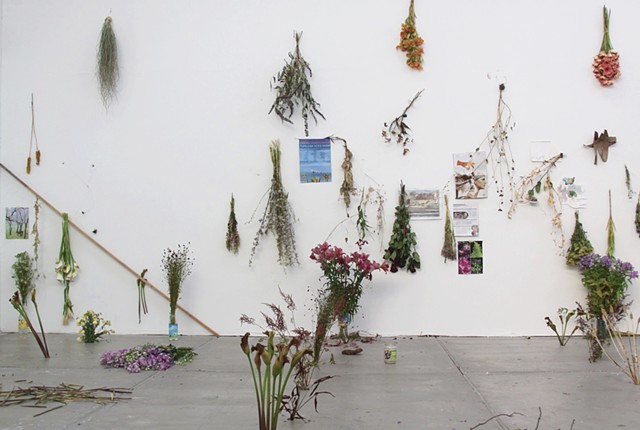Kaus Australis Residency
I was an Artist chosen by Carl Berg Gallery to experience a residency with Kaus Australis in Holland. I spent my time there dumpster diving in a dumpster behind a floral shop in Rotterdam. I studied rates of decomposition of these flowers. This image image was a studio still of of the last day of my residency.
In Rotterdam, Holland, I studyied and pondered over the works of the Dutch Still-Life Masters. Viewing the work in the actual region in which it was produced, not only provided the context (landscape and cultural ideology) for the Still-Life paintings, but also planted ideas of taking on the genre through the medium of installation.
I felt inspired as I began to see painting as an active explosion on a surface, capable of doing something; a theater just waiting for a performance. Before I knew it, that space for performance, had become a site for a “happening” inside of my studio.
I borrowed nails from Evan, a hammer from Kaus, and plucked brilliant bouquets out of a dumpster from behind a flower shop in Pelliweg, Holland. I felt as if I had stepped into the space between each flower, behind the vase, and around the objects on the table. Orange peels piled on the floor, books strewn, water bottles left on the table, nails left bold and unhidden, found string and spools of wire lay on the floor, a ladder in the room-the studio.
I began to experiment with rates of decomposition. The floor of the studio had a grid-like series of holes; 48 in number, 2 inches deep and equally spaced apart. I placed the flowers that I wanted to see decay, at a faster rate, inside of these holes full of air. Other bouquets were placed inside of water bottles and spaghetti sauce jars full of water, to slow the rate of decomposition. And then these bouquets, too, once dry were added to the walls to finish their slow final stages of decomposing. I attached the groupings of flowers to the walls using tacks, nails, and string and a very organic composition. I read voraciously and collected cards from shows, relating to Still-Life, and pinned what I was learning onto the wall.
Now that the distillation process is occurring, I have a bit more of an understanding as to what a “happening” truly is. I had taken Dutch Still-life painting into question through the sculptural aspects of the work, thus producing different truths than I could have found from viewing it solely, as a painting on the wall.
In my practice I interact with plants in a way that allows me to examine their life cycle more closely. I used this residency to surround myself with this process, in order to possibly open up a deeper understanding of my interest. I lived in a paradoxical state as I ate, drank, and slept in the deterioration process.
